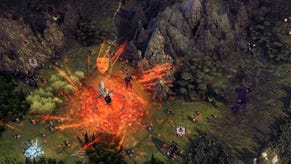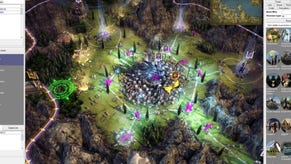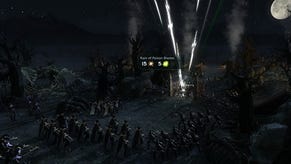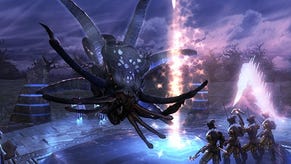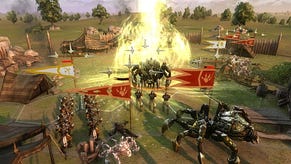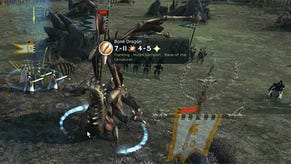Wot I Think: Age Of Wonders III
Emerging from the shadows
It's only been a month and a half since I wrote my mega-preview of Age Of Wonders III and spending around fifteen hours with a review copy of the game hasn’t done a great deal to change my mind about its many merits. It hasn’t extended its tendrils to tickle any deeper fancies either, although I’ll concede that the world is a little weirder and more wonderful than my initial expeditions suggested. I've spent many hours with the long-awaited strategy sequel and here's wot I think.
When I started writing for RPS, I didn't expect I'd ever be reviewing an Age of Wonders sequel. Now, thanks to reclaimed publishing rights and a bit of Notch magic, the venerable series has returned. It's still capable of eating my evenings and nights, but thankfully I don't have a degree to work on this time around. In fact, playing the game has been my job for the last few days, which is an almost entirely pleasing state of affairs. I've barely complained about the hard labour and long hours at all this week.
Even though I'm weary of dungeons, dragons, Tolkiens and toadstools, an army of fairies going head to head with an assembly of theocratic orcs is quite a sight to see. Mixing up classes and races creates some unusual combinations. Winged avenger orcs look like green-skinned archangels soaring across the battlefield and the dreadnaught class ensures that everyone can get involved with some steampunk sorcery rather than just the dwarves. In general, racial traits are inherent while class-specific skills and units are unlocked through construction and research.
This means that a leader’s choice of profession is considerably more important than the species they were born as, which makes the world of Age of Wonders remarkably progressive as far as fantasy environments go, even if many of the lady elves do look in danger of catching a chill. No longer are dwarves doomed to a life in the mines. Infant orcs shall no longer be placed straight into barbarian school and wee draconians can aspire to be more than a giant’s Zippo.
Leaders and the heroes they hire act as a solid core for each empire in the game. To destroy an enemy entirely, the leader must be killed and the Throne destroyed before the swine can regenerate three turns later, like a delayed Doctor Who. They are precious, those leaders, and eventually become formidable units in their own right, capable of casting powerful spells and laden down with shiny magical trinkets. From time to time, armies and dens of monsters will fall, freeze or frazzle before them but they’re not omnipotent. Without backup, even the mightiest can’t compete against the sort of odds a smart opponent will pitch against them.
Age of Wonders hasn’t evolved into an RPG, it’s just spent some time over the eleven years since it last appeared smooching with RPGs. At its core, the game is still about building settlements, expanding them and creating armies. Leaders now act as a much sharper point at the head of those armies and provide each opponent with an extra dollop of personality.
It’s been such a long time since I played the previous games in the series that I can’t remember if they were quite as combat-focused. I think they were, since most of my memories involve tactical battles and fireballs raining down from the skies, but AOW III is surprisingly aggressive. Wandering monsters aren’t anywhere near as threatening as the city-smiting creatures that haunt Warlock II but independent settlements jostle for space, and when you meet your actual opponents they’ll often make your life a misery.
That’s a good thing. Not because I want you to be miserable – we’re all friends here – but because it’s a sign of AI that is capable of challenging and confounding. I’m not going to argue that it has functionally complex routines or an in-built unpredictability because I really don’t know, but I can tell you that I’ve received my fair share of beatings during the two campaigns and on a lovely assortment of random maps.
The campaigns are fine. That’s about all I have to say about them. I didn’t finish the second one and the first is tutorial-heavy, though worth playing to get a handle on everything. It’s important to know how the game works not because it is doing anything that fantasy 4X games of the past haven’t done but because the weighting of the various elements isn’t quite as you might expect.
Some strategy games allow players to be as flexible as a politician’s promise but others encourage certain types of play through the details of their number-crunching and rulesets. AOW III rewards expansion. It doesn’t like players who dawdle, looking at the scenery and trying to create the perfect society. Cities are machines that build the tools of war, whether that calls for a granary to help feed the people who make swords or a mana battery/library combo that functions like a miniature Manhattan Project.
To gain the spoils of war, you must simultaneously act like a spoiled brat (taking everything from everyone) and spoil the party for the rest of the world. It is possible to win a diplomatic victory of sorts, by allying with some people and killing everybody else, but the ultimate goal on every map is to be the last leader standing. The flow of the game is a very direct and pure interpretation of the process that describes the genre – ‘eXplore, eXpand, eXploit, and eXterminate’.
With all that war to be done, it’d be more than bit rubbish if the combat was rubbish. It isn’t. It’s very very good indeed, in fact, and not just during the grid-based tactical skirmishes. On the strategic map, positioning and terrain are hugely important, just as they are in the zoomed-in combat portions of the game. Even though an individual army can only contain six units, clever manipulation of the adjacent hex rule during pre-engagement planning can lead to enormous brouhahas. Execute a plan without much thought and you can find yourself horribly outnumbered.
It’s not a new system for the series but revisiting it reminded me how cleverly the tactical combat level is integrated, allowing for battles that change in scale dramatically as a campaign unfolds, while avoiding the problem of tedious stacks of doom. As for the actual tactical combat, it can be repetitive during the early stages of a campaign, but has enough depth to keep me from automating every battle.
Special mention must go to the random map generator, which is the core of the whole experience as far as I’m concerned. Not only does it create interesting and attractive worlds, it also contains plenty of customisation options. Most of those don’t affect the way the world is constructed but rather the pace of the game – there are choices concerning everything from the size of starting cities to the number of wandering monsters.
Pleasingly, all of these can be randomised, creating not only maps but scenarios that neatly fit into whatever story you might want to apply to them. Maybe you’ll be the leader of a powerful empire, already in its prime but now beset by hordes of creatures as a new wintry era arrives. Or maybe you’ll be a plucky goblin rogue attempting to carve out a kingdom of thieves in a barren land.
More variety would be welcome, in unit types and spells. I sometimes feel like I’ve reached the end of production and research paths long before a campaign has run its course. But that’s a minor complaint given how solidly constructed the game is. I don’t find it quite as exciting as Warlock II, which has such an unusual and habit-shattering structure, but they are very different beasts, despite appearances.
Age of Wonders III could have been constructed in the golden age of turn-based strategy. In fact, given the competition it’s going to have as the year goes on, it’s an additional reason to believe that we might be heading for that golden age right now.
Age Of Wonders III is out on March 31st.








